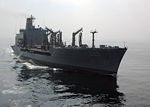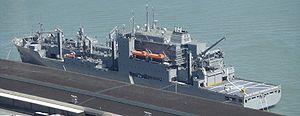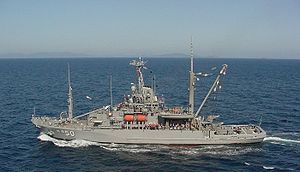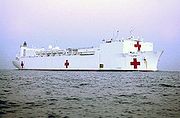
Naval Fleet Auxiliary Force
Encyclopedia
The 42 ships of the Military Sealift Command
's Naval Fleet Auxiliary Force are the supply lines to U.S. Navy ships at sea. These ships provide virtually everything that Navy ships need, including fuel, food, ordnance, spare parts, mail and other supplies. NFAF ships enable the Navy fleet to remain at sea, on station and combat ready for extended periods of time. NFAF ships also conduct towing, rescue and salvage operations or serve as floating medical facilities. All NFAF ships are government owned and crewed by civil service mariners. Some of the ships also have a small contingent of Navy personnel aboard for operations support, supply coordination and helicopter operations.
 Fifteen fleet replenishment oiler
Fifteen fleet replenishment oiler
s, the largest subset of Naval Fleet Auxiliary Force ships, provide fuel to deployed Navy ships at sea, as well as to their assigned aircraft. Oilers and the ships they refuel sail side by side as fuel hoses are extended across guide wires. Underway replenishment
of fuel dramatically extends the time a Navy battle group can remain at sea. The fifteen ships of the oiler fleet are as follows:
 Two ammunition ships supply ordnance to Navy combatants at sea, providing service through a combination of alongside transfers and vertical replenishment lifts via helicopter. The ammunition ships of the Auxiliary Fleet are:
Two ammunition ships supply ordnance to Navy combatants at sea, providing service through a combination of alongside transfers and vertical replenishment lifts via helicopter. The ammunition ships of the Auxiliary Fleet are:
.jpg) MSC's four fast combat support ships provide one-stop shopping to the fleet for fuel, ammunition, food and other cargo. These ships are especially valuable because of their speed and ability to carry all the essentials to replenish Navy ships at sea. MSC's fast combat support ships, formerly sailor-operated, transferred to MSC for civil service crewing beginning in 2001.
MSC's four fast combat support ships provide one-stop shopping to the fleet for fuel, ammunition, food and other cargo. These ships are especially valuable because of their speed and ability to carry all the essentials to replenish Navy ships at sea. MSC's fast combat support ships, formerly sailor-operated, transferred to MSC for civil service crewing beginning in 2001.
 The eleven Military Sealift Command Lewis and Clark dry cargo/ammunition ships
The eleven Military Sealift Command Lewis and Clark dry cargo/ammunition ships
are a new class of ships dedicated to the Naval Fleet Auxiliary Force. These ships are able to deliver ammunition, provisions, stores, spare parts, potable water and petroleum products to the Navy's carrier strike group
s and other naval forces worldwide. Designed to operate for extended periods at sea, the Lewis and Clark-class ships have improved cargo handling equipment that increases efficiency and makes the ships more cost effective to operate and maintain. All the Lewis and Clark-class ships are named after great American pioneers. Fourteen ships of this class have been ordered with three more still to be delivered. These ships are listed as follows:
Ordered but not yet delivered are:
- Construction commenced 22 September 2009 - Keel laid 26 October 2010
_underway.jpg) The Military Sealift Command's fleet ocean tugs provide the Navy fleet with towing service and can tow Navy vessels as large as battleships. When augmented by Navy divers, fleet ocean tugs assist in the recovery of downed ships and aircraft. In addition, when carrying specialized equipment, the fleet ocean tugs can also perform submarine rescue operations. The Auxiliary fleet's tugs are:
The Military Sealift Command's fleet ocean tugs provide the Navy fleet with towing service and can tow Navy vessels as large as battleships. When augmented by Navy divers, fleet ocean tugs assist in the recovery of downed ships and aircraft. In addition, when carrying specialized equipment, the fleet ocean tugs can also perform submarine rescue operations. The Auxiliary fleet's tugs are:
 The MSC's four rescue and salvage ship
The MSC's four rescue and salvage ship
s recover objects from the sea, tow or debeach stranded vessels and provide firefighting assistance. These ships, like fleet ocean tugs, are able to lift objects as heavy as downed ships and aircraft. The key advantage of these ships is their ability to rapidly deploy divers to conduct rescue and salvage operations. They are identified as follows:
 MSC's Naval Fleet Auxiliary Force operates the Navy's two hospital ship
MSC's Naval Fleet Auxiliary Force operates the Navy's two hospital ship
s each containing 12 operating rooms and up to 1,000 beds. The ships are normally kept pierside in reduced operating status, each with a small contingent of MSC civil service mariners and Navy hospital personnel aboard to ensure the ships are ready should they be needed. When called into action, they can get underway in five days with an expanded crew of more than 60 civil service mariners and an expanded medical staff of up to approximately 1,200 military medical personnel. The Auxiliary Fleet's hospital ships are the:
Military Sealift Command
The Military Sealift Command is a United States Navy organization that controls most of the replenishment and military transport ships of the Navy. It first came into existence on 9 July 1949 when the Military Sea Transportation Service became solely responsible for the Department of Defense's...
's Naval Fleet Auxiliary Force are the supply lines to U.S. Navy ships at sea. These ships provide virtually everything that Navy ships need, including fuel, food, ordnance, spare parts, mail and other supplies. NFAF ships enable the Navy fleet to remain at sea, on station and combat ready for extended periods of time. NFAF ships also conduct towing, rescue and salvage operations or serve as floating medical facilities. All NFAF ships are government owned and crewed by civil service mariners. Some of the ships also have a small contingent of Navy personnel aboard for operations support, supply coordination and helicopter operations.
Fleet Replenishment Oilers

Replenishment Oiler
A replenishment oiler or fleet tanker is a naval auxiliary ship with fuel tanks and dry cargo holds, which can replenish other ships while underway in the high seas. Such ships are used by several countries around the world....
s, the largest subset of Naval Fleet Auxiliary Force ships, provide fuel to deployed Navy ships at sea, as well as to their assigned aircraft. Oilers and the ships they refuel sail side by side as fuel hoses are extended across guide wires. Underway replenishment
Underway replenishment
Underway replenishment or replenishment at sea is a method of transferring fuel, munitions, and stores from one ship to another while under way.-History:...
of fuel dramatically extends the time a Navy battle group can remain at sea. The fifteen ships of the oiler fleet are as follows:
Ammunition Ships

Fast Combat Support Ships
.jpg)
Dry Cargo/Ammunition Ships

Lewis and Clark class dry cargo ship
The Lewis and Clark class of dry cargo ship is the next class of Combat Logistics Force underway replenishment vessels to be constructed for the United States Navy's Military Sealift Command. Lewis and Clark-class ships will replace the existing fifteen Mars- and Sirius-class combat store ships...
are a new class of ships dedicated to the Naval Fleet Auxiliary Force. These ships are able to deliver ammunition, provisions, stores, spare parts, potable water and petroleum products to the Navy's carrier strike group
Carrier Strike Group
A carrier strike group is an operational formation of the United States Navy. It is composed of roughly 7,500 personnel, an aircraft carrier, at least one cruiser, a destroyer squadron of at least two destroyers and/or frigates, and a carrier air wing of 65 to 70 aircraft...
s and other naval forces worldwide. Designed to operate for extended periods at sea, the Lewis and Clark-class ships have improved cargo handling equipment that increases efficiency and makes the ships more cost effective to operate and maintain. All the Lewis and Clark-class ships are named after great American pioneers. Fourteen ships of this class have been ordered with three more still to be delivered. These ships are listed as follows:
Ordered but not yet delivered are:
- Construction commenced 22 September 2009 - Keel laid 26 October 2010
- USNS Unnamed T-AKE-14
Fleet Ocean Tugs
_underway.jpg)
Rescue and Salvage Ships

Rescue and salvage ship
Rescue and salvage ships in the United States Navy were common during World War II. Their purpose was to come to the rescue of stricken ships, usually because of their towing ability, and to tow away ships damaged because of enemy action or engine failure....
s recover objects from the sea, tow or debeach stranded vessels and provide firefighting assistance. These ships, like fleet ocean tugs, are able to lift objects as heavy as downed ships and aircraft. The key advantage of these ships is their ability to rapidly deploy divers to conduct rescue and salvage operations. They are identified as follows:
Hospital Ships

Hospital ship
A hospital ship is a ship designated for primary function as a floating medical treatment facility or hospital; most are operated by the military forces of various countries, as they are intended to be used in or near war zones....
s each containing 12 operating rooms and up to 1,000 beds. The ships are normally kept pierside in reduced operating status, each with a small contingent of MSC civil service mariners and Navy hospital personnel aboard to ensure the ships are ready should they be needed. When called into action, they can get underway in five days with an expanded crew of more than 60 civil service mariners and an expanded medical staff of up to approximately 1,200 military medical personnel. The Auxiliary Fleet's hospital ships are the:

